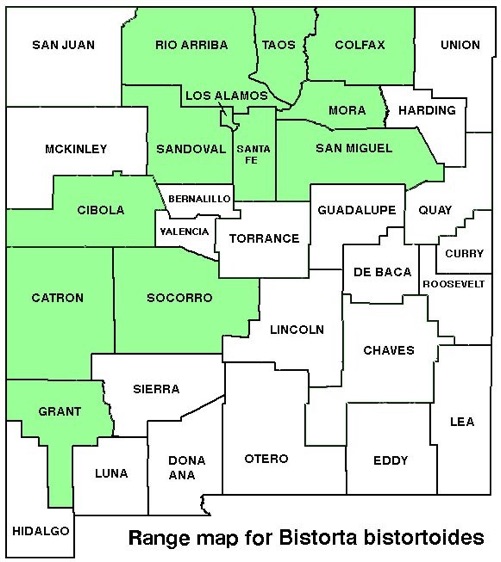WILDFLOWERS OF NEW MEXICO

Often forming dense colonies in wet, mountain meadows, Bistort’s 7–16-inch tall stems are topped with a dense, cylindrical spike of small, white to pale pink flowers. Note the reddish stems and the elliptic, pointed basal leaves on long stems.
FLOWER: July–September. Erect stems with spikes 3/4–1 1/2-inches long (2–4 cm), densely packed with white to pinkish flowers with 3/16-inch long (5 mm) petal-like tepals, stamens protrude beyond the flower; fruit a shiny brown seed 1/8-inch long (not bulblets on the spike as in B. vivipara).
LEAVES: Basal and alternate on stem. Mostly basal with stems (petioles) 1–2 3/4-inches long (3–7 cm). Blades elliptic to lance-shaped, 2–10-inches long (5–25 cm), surfaces hairless, margins entire, tip usually pointed.
HABITAT: Moist gravelly, loam, alluvial soils, bogs, marshes, meadows; ponderosa, spruce-fir forests, subalpine and alpine meadows, tundra.
ELEVATION: 7,000–12,500 feet.
RANGE: AZ, CA, CO, UT; widespread in Rocky Mts. and westward.
SIMILAR SPECIES: Alpine Bistort, B. vivipara, in similar habitats, forms bulblets below the flowers on the spike and rarely produces seeds.
NM COUNTIES: Northern and western NM mountains in high-elevation, wet habitats: Catron, Cibola, Colfax, Grant, Los Alamos, Mora, Rio Arriba, San Miguel, Sandoval, Santa Fe, Socorro, Taos.









AMERICAN BISTORT
BISTORTA BISTORTOIDES
Buckwheat Family, Polygonaceae
Perennial herb



























THE CONTENTS OF THIS WEBSITE ARE COPYRIGHTED AND CANNOT BE USED
WITHOUT PERMISSION OF GEORGE OXFORD MILLER

















Stem leaf.








EMAIL ME







